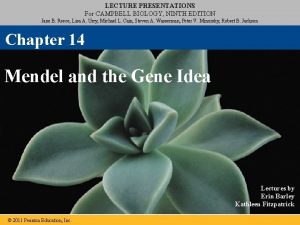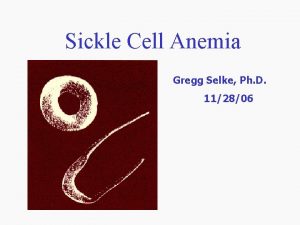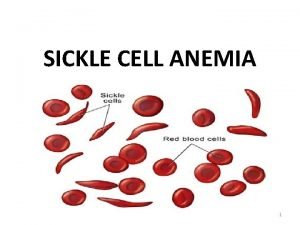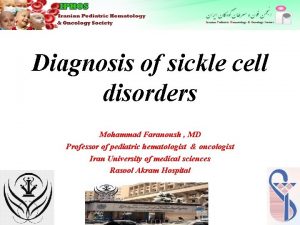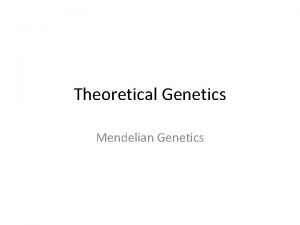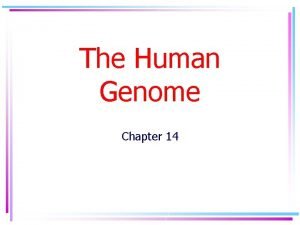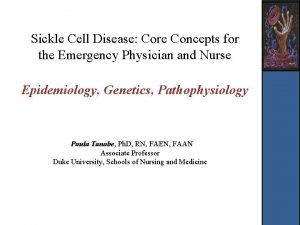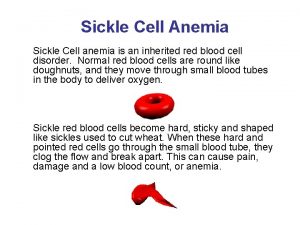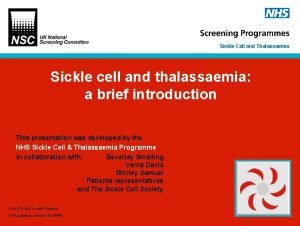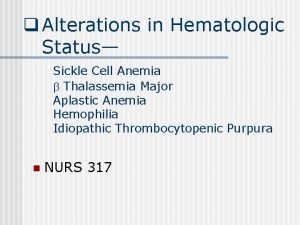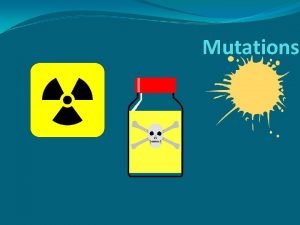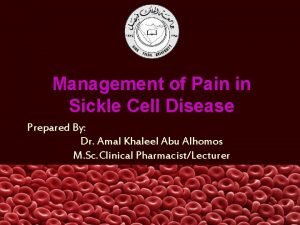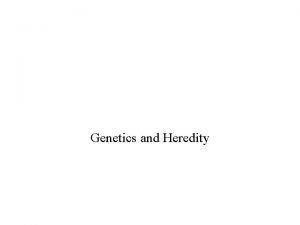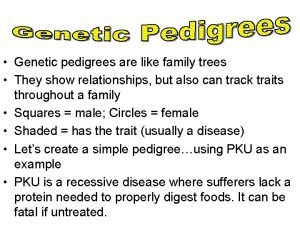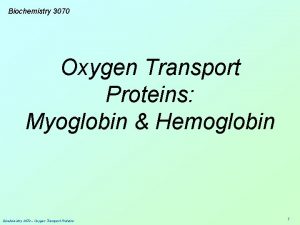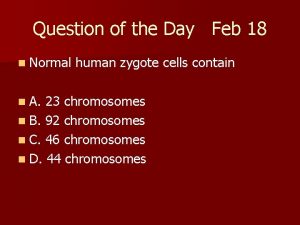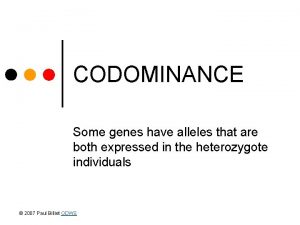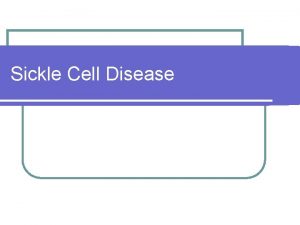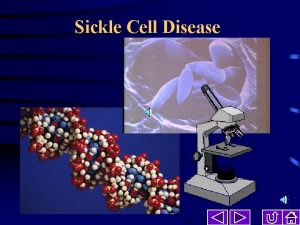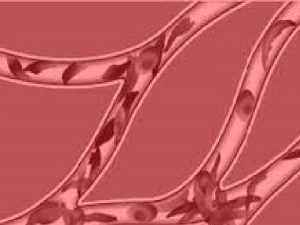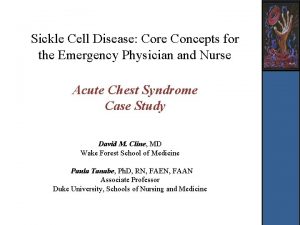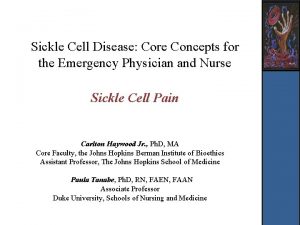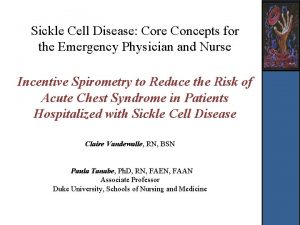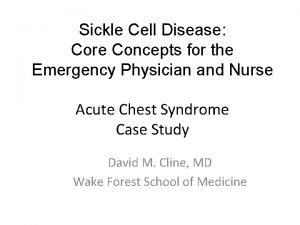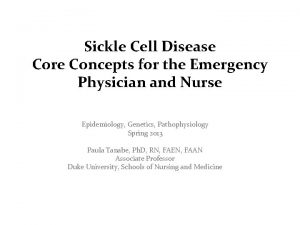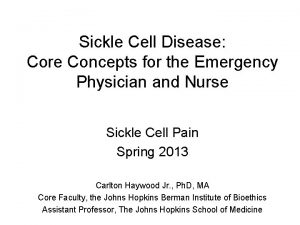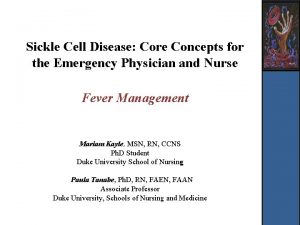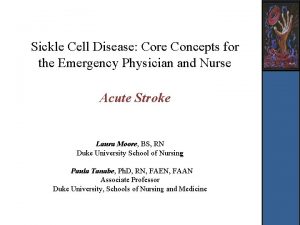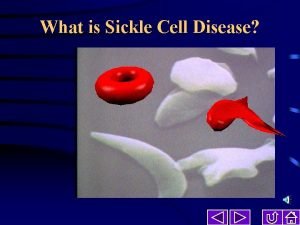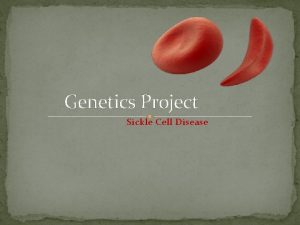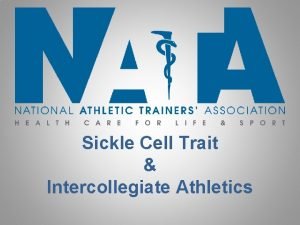Sickle Cell Disease Core Concepts for the Emergency


















- Slides: 18

Sickle Cell Disease: Core Concepts for the Emergency Physician and Nurse High ED Utilization and Perceptions of Opioid Addiction Hants Williams, RN, BSN Ph. D Student Duke University School of Nursing Paula Tanabe, Ph. D, RN, FAEN, FAAN Associate Professor Duke University, Schools of Nursing and Medicine

Objectives • Describe rates of hospital utilization for persons with SCD • Discuss opioid addiction in SCD • Present recommendations to assist patients with high ED use & address misconceptions regarding opioid addiction in SCD

Pretest- Question 1 Which reason is not related to high utilization of hospital services by persons with SCD? a. b. c. d. Renal disease Lack of primary Care Between 18 to 24 years of age Opioid addiction

Pretest- Question 2 What is the estimated rate of addiction to opioids in persons with SCD? a. b. c. d. Under 10% Between 10 -30% Above 30% 100%

Hospital Utilization in SCD • In 2010, SCD had the highest 30 -day hospitalization rate of any disease - 32% 1 • 20% of patients with SCD account for approximately 54% of emergency department (ED) visits. 2 These patients are often referred to as high utilizers • High utilizers can be defined as patients with three or more visits to an ED in one year 3

Characteristics of High Utilizers When compared to individuals with < 3 hospitalizations per year, high users: - Have a lower 5 year survival rate 4 - Have higher pain ratings & decreased quality of life 3 - Report more distrust toward medical professionals 5 - Are more likely to have family members with a psychiatric illness 6

Factors Associated with Higher Utilization • Age 18 -30 9 • Provider underuse of pain medications due to misconceptions of drug addiction 10 • Lack of access to primary care 16, 17 • Disease severity – Genotypes SS and SB 0 compared to SC, SB+ – Previous diagnoses of aseptic necrosis, renal disease, septicemia, & mood disorders 7 – History of Acute Chest Syndrome 8

Misconceptions About Opioid Addiction • Many clinicians believe a large proportion of patients with SCD are addicted to opioids – 53% of ED physicians thought more than 20% of patients with SCD were addicted to pain meds 11 – 63% of nurses believed patients with SCD were addicted to pain meds 12

Facts About Opioid Addiction • In SCD, opioid addiction is uncommon & similar to that found in other chronic diseases 13 • Opioid dependence in SCD has been estimated at 4% 13 • Misperceptions by staff of analgesic addiction has a more important influence on problematic pain management than genuine analgesic addiction 14

Pseudoaddiction • Attempts to control pain can resemble symptoms of addiction, making patients vulnerable to misperceptions of addiction, know as pseudoaddiction 15 • Pseudoaddiction resembles symptoms of drug dependence, but occurs in the presence of pain, or attempts to control pain • Pseudoaddiction in SCD – % displaying pseudoaddiction : 31% 13

Behaviors Related to Pseudoaddiction • Common behaviors seen in persons with SCD that can be misinterpreted as addiction – More painful episodes managed at home 14 – Greater use of prescription analgesics at home 14 – Attempts to give up or cut down opioid use 13 – Opioid tolerance 13 – Social impairment 13 – Greater use than intended 13 – Failing role obligations 13

Recommendations – High Utilizers • It is important to identify patients without a usual source of care, & provide them with coordinated care • When appropriate, make referrals to psychologists or social workers to help address unmet psychosocial needs that may be contributing to high healthcare utilization

Recommendations - Addiction • Because risk of addiction seems to be no greater in patients with SCD, clinicians are encouraged to treat the pain experienced by the patient fully • Evidence suggests that the undertreatment of pain can lead to pseudoaddiction, early readmission, and increased fear of future crisis episodes 13, 14

Clinical Scenario • Cut and paste the link below into your browser to view this short video • https: //www. youtube. com/watch? v=9 x. J 4 Vwt. B t. Rw

Posttest- Question 1 Which reason is not related to high utilization of hospital services by persons with SCD? a. b. c. d. Renal disease Lack of primary Care Between 18 to 24 years of age Opioid addiction

Posttest- Question 2 What is the estimated rate of addiction to opioids in SCD? a. b. c. d. Under 10% Between 10 -30% Above 30% 100%

Posttest Answers & Rationale • Question 1 – Answer: d) Opioid addiction – Rationale: Common reasons for high utilization include renal disease, lack of primary care, and between the ages of 18 -24. There is no evidence to support a relationship between high hospital utilization and opioid addiction in persons with SCD 1, 3, 6, 7, 16, 17 • Question 2 – Answer: a) Under 10% – Rationale: Opioid addiction is uncommon and similar to that found in other chronic diseases; Opioid dependence in SCD has been estimated at 4% 13, 14

References 1. Elixhauser A (AHRQ), Steiner C (AHRQ). Readmissions to U. S. Hospitals by Diagnosis, 2010. HCUP Statistical Brief #153. April 2013. Agency for Healthcare Research and Quality, Rockville, MD. http: //www. hcup-us. ahrq. gov/reports/statbriefs/sb 153. pdf. 2. Elander, J. , Marczewska, M. , Amos, R. , Thomas, A. , & Tangayi, S. (2006). Factors Affecting Hospital Staff Judgments About Sickle Cell Disease Pain. J Behav Med, 29(2), 203 -214. 3. Aisiku, I. P. , Smith, W. R. , Mc. Clish, D. K. , Levenson, J. L. , Penberthy, L. T. , Roseff, S. D. , . . . Roberts, J. D. (2009). Comparisons of high versus low emergency department utilizers in sickle cell disease. Ann Emerg Med, 53(5), 587 -593. doi: 10. 1016/j. annemergmed. 2008. 07. 050 4. Platt, O. S. , Thorington, B. D. , Brambilla, D. J. , Milner, P. F. , Rosse, W. F. , Vichinsky, E. , & Kinney, T. R. (1991). Pain in sickle cell disease. Rates and risk factors. N Engl J Med, 325(1), 11 -16. doi: 10. 1056/nejm 199107043250103 5. Haywood, C. , Lanzkron, S. , Ratanawongsa, N. , Bediako, S. M. , Lattimer, L. , Powe, N. R. , & Beach, M. C. (2010). The association of provider communication with trust among adults with sickle cell disease. J Gen Intern Med, 25(6), 543 -548. 6. Carroll, P. C. , Haywood, C. , Jr. , Hoot, M. R. , & Lanzkron, S. (2013). A preliminary study of psychiatric, familial, and medical characteristics of highutilizing sickle cell disease patients. Clin J Pain, 29(4), 317 -323. 7. Carroll, C. P. , Haywood, C. , Jr. , & Lanzkron, S. (2011). Prediction of onset and course of high hospital utilization in sickle cell disease. J Hosp Med, 6(5), 248 -255. doi: 10. 1002/jhm. 850 8. Bernard et al. , 2007. ↵ Bernard A. W. , Yasin Z. , Veukat A. Acute chest syndrome of sickle cell disease. Hosp. Physician 2007; 44: 15 -23. 9. Brousseau, D. C. , Owens, P. L. , Mosso, A. L. , Panepinto, J. A. , & Steiner, C. A. (2010). Acute care utilization and rehospitalizations for sickle cell disease. Jama, 303(13), 1288 -1294. doi: 10. 1001/jama. 2010. 378 10. Labbé, E. , Herbert, D. , & Haynes, J. (2006). 'Physicians' Attitude and Practices in Sickle Cell Disease Pain Management': Erratum. J Palliat Care, 22(1). 11. Shapiro, B. S. , Benjamin, L. J. , Payne, R. , & Heidrich, G. (1997). Sickle cell-related pain: Perceptions of medical practitioners. Dulwich Centre Review, 14(3), 168 -174. 12. Pack-Mabien, A. , Labbe, E. , Herbert, D. , & Haynes, J. , Jr. (2001). Nurses' attitudes and practices in sickle cell pain management. Appl Nurs Res, 14(4), 187 -192. doi: 10. 1053/apnr. 2001. 26783 13. Elander, J. , Lusher, J. , Bevan, D. , & Telfer, P. (2003). Pain management and symptoms of substance dependence among patients with sickle cell disease. Social Science & Medicine, 57(9), 1683 -1696. 14. Elander, J. , Lusher, J. , Bevan, D. , Telfer, P. , & Burton, B. (2004). Understanding the causes of problematic pain management in sickle cell disease: evidence that pseudoaddiction plays a more important role than genuine analgesic dependence. J Pain Symptom Manage, 27(2), 156 -169. doi: 10. 1016/j. jpainsymman. 2003. 12. 001 15. Lusher, J. , Elander, J. , Bevan, D. , Telfer, P. , & Burton, B. (2006). Analgesic addiction and pseudoaddiction in painful chronic illness. Clin J Pain, 22(3), 316 -324. doi: 10. 1097/01. ajp. 0000176360. 94644. 41 16. Tanabe P, Hafner JW, Martinovich Z, Artz N. Adult emergency department patients with sickle cell pain crisis: results from a quality improvement learning collaborative model to improve analgesic management. Acad. Emerg. Med. 2012; 19(4): 430 -438. 17. Frei-Jones MJ, Field JJ, De. Baun MR. Risk factors for hospital re-admission within 30 days: a new quality measure for children with sickle cell disease. Pediatr. Blood Cancer. 2008; 52: 481 -485.
 Gene therapy for sickle cell disease
Gene therapy for sickle cell disease Co dominance example
Co dominance example Sickle cell anemia
Sickle cell anemia Sickle cells
Sickle cells Hemoglobin electrophoresis
Hemoglobin electrophoresis Multiple alleles example blood type
Multiple alleles example blood type Sickle cell karyotype
Sickle cell karyotype Life expectancy of sickle cell patients
Life expectancy of sickle cell patients Anemia structure
Anemia structure Difference between sickle cell anaemia and thalassemia
Difference between sickle cell anaemia and thalassemia Aplastic crisis
Aplastic crisis What type of mutation is cri du chat syndrome
What type of mutation is cri du chat syndrome Protein synthesis and mutations
Protein synthesis and mutations Pethidine in sickle cell
Pethidine in sickle cell Sickle cell karyotype
Sickle cell karyotype Sickle cell pedigree
Sickle cell pedigree Sickle cell hemoglobin structure
Sickle cell hemoglobin structure Sickle cell punnett square
Sickle cell punnett square Is sickle cell anemia codominant
Is sickle cell anemia codominant
